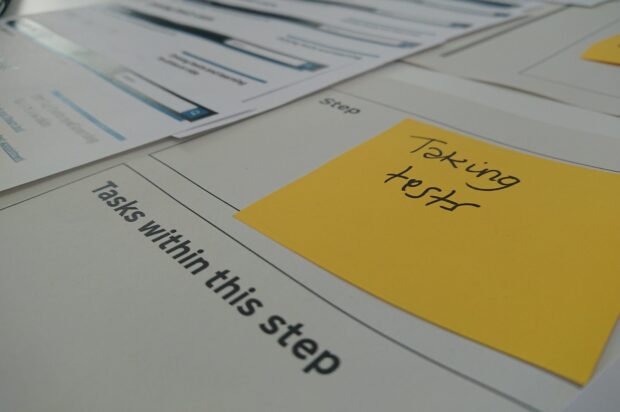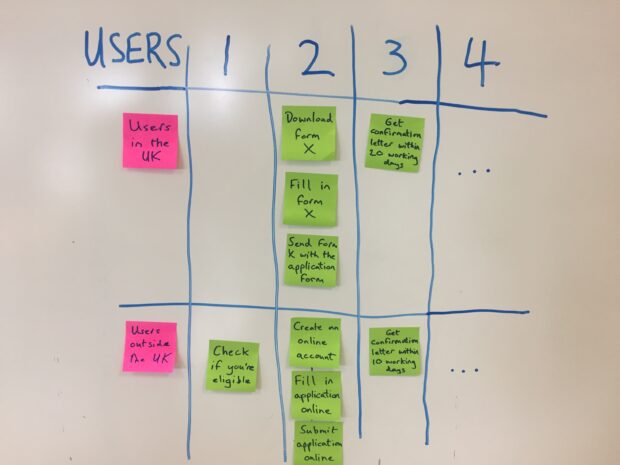
The new Service Standard asks government service teams to “work towards creating a service that solves one whole problem for users, collaborating across organisational boundaries where necessary”.
At GDS we’ve been applying this principle to improving content and user journeys on GOV.UK. We’ve been doing this by mapping out all the tasks within an end-to-end service and the content that helps users to complete them.
Users don’t go to GOV.UK to read information – they use it as a way to complete a task. Considering content from this perspective can help us plan content improvements around what users are actually trying to do.
We know there are lots of other teams across government who want to work towards solving whole problems for users, so we’re sharing our approach here.
Improving content that makes up government services
When we start working on an end-to-end service, we define the users, then map out the journey. This process shows us what tasks users need to complete and highlights where the content doesn’t help them to do this. Mapping your service like this can help you identify:
- the most important content in the user journey
- content gaps
- duplicated content
- content trying to meet multiple needs
- content covering a user need that’s being met by another department
It gives you a structure when you’re planning content improvement projects, so you can be confident that your content meets a real user need and that you’ve covered all the points in a user’s journey.
We do the mapping in 4 stages: scoping, auditing, journey mapping and content mapping. These activities work best when you have input from every area that’s involved in the service, for example: policy, user research, service design and content.
Scoping the end-to-end service
Start by defining your users, and the start and end points for their journey. You can run this as a collaborative activity using the questions below. You may have more than one answer for each question. The answers can be framed as personas, eligibility criteria or scenarios people are in.
1. Who is the service for?
The main group of people who will use the service.
For example, for ‘Come to the UK to get married’:
Anyone who wants to get married in the UK but doesn’t currently live here.
2. Who else might use the service?
Anyone else who might use it, but for whom the service is not specifically designed.
For example, for ‘Come to the UK to get married’:
The partner of someone coming to the UK to get married.
3. Who is the service not for?
Anyone who should follow a different process.
For example, for ‘Come to the UK to get married’:
Guests or other family members of the couple who want to get married.
People who are already in the UK and want to get married.
4. What is the starting point for the journey?
Think about what situation the user is in when they start their journey.
For example, for ‘Come to the UK to get married’:
I want to have my wedding in the UK.
5. What is the end point for the journey?
Think about what has changed for the user during the journey – what’s the outcome?
For example, for ‘Come to the UK to get married’:
I have got married in the UK.
Auditing the content within the end-to-end service
Making a list of the content on GOV.UK that relates to your service will help you understand what content users might come across and how it’s being used.
You can do this by:
- using the GOV.UK browse menu as a starting point
- looking at the links between content
- using the Content Data tool
- using Google Analytics to see how users are arriving at your content – are there any popular starting points?
- using Google Analytics to see what search terms people use that could be associated with your service – search for these and see what comes up
- checking what other organisations tell people about the process (for example, Citizens Advice)
Print out screenshots of all the content you find. Include all chapters of guides. You’ll need this later on in the ‘content mapping’ section.
Make them A6 or A5. You need to be able to read the headings on the page so you know what they relate to, but not the page itself in detail. If the screenshot is really long, print off the top section.
Journey mapping
On a wall or board, stick up the journey start and end points that you agreed during the scoping activity. You will map the journey between these points.
Stick up your agreed users on the left side of the board or wall, in a list.
Write up the online and offline tasks in the order the user needs to do them. Make a note of:
- things that happen to the user – for example, receiving a confirmation letter
- costs
- timings and deadlines
- anything the user needs to know or understand to do a task
Note anything that users currently struggle with.
Break down the tasks into the smallest actions the user needs to take. For example, applying for something could be broken down into:
- download an application form
- print off and fill in the form
- send the form to the address on the form
- receive a confirmation of your application within 5 working days
When you have finished the tasks for your main user group, look at the other users you identified. Ask:
- are there any extra tasks for any of these users?
- are there any tasks they have to do differently?
- are there any tasks they do not have to do?
Write these up below the task they apply to, next to the user group.

Content mapping
Split into groups of 2 or 3. Give each group a pile of screenshots of the content from your audit.
Ask the groups to look through the screenshots and stick them up next to the task they relate to on the wall or board. Keep a space for things that aren’t relevant for any content. Don’t spend long reading each one – just make a guess or put them aside.
When they’ve finished sticking the screenshots up, discuss what they noticed – are there any areas where content is missing? Are there any areas where there is duplicate content? Is the same piece of content needed for multiple tasks?
Planning the content improvements
Now you’ve mapped the existing content to the journey, you’re ready to start planning how to improve that content.
If there are any tasks within the journey that you don’t have content for, decide who should create new content to fill those gaps. Keep each piece of content focused on one task, to make it easy for users to follow.
For tasks you have more than one piece of content for, identify the owners of the content. Agree which single piece of content you’ll use for this task, and unpublish the others.
Where you have one piece of content that covers multiple tasks, split it up so that each piece of content covers one task only.
Finally, consider how users navigate between different parts of the journey. Use analytics to find out where users are dropping out of the journey currently. Help users to navigate the next task after they’ve completed one, so that it’s easy for them to complete all the tasks in the right order and achieve their overall goal.
2 comments
Comment by Denise Eisner posted on
At which point do you find that it's essential to have a subject matter expert involved?
Comment by Matt Clear posted on
Hi Denise,
Journey mapping is when you absolutely have to have the subject matter expert involved. It's essential for getting the journey right. Having those discussions about what users need to do and when sooner rather than later should also help to get them on board with changes to the content.
We also do the scoping with them, or at the very least get them to validate our conclusions. And we try to involve them in content mapping if we can - that can really help them to understand the problems with the existing content.